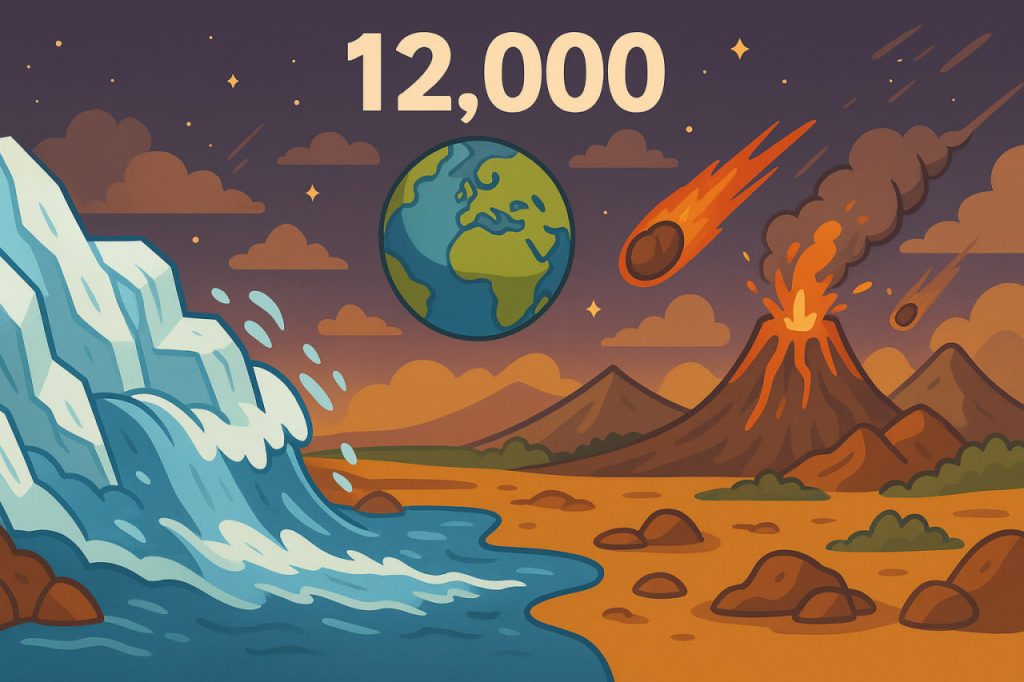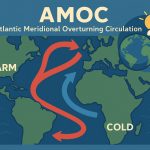Roughly 12,000 years ago, our planet went through one of the most turbulent and transformative periods in its history. This era marked the end of the last Ice Age and the dawn of the Holocene, the warm and stable epoch in which human civilization would eventually flourish. But this transition was anything but gentle. It was a time of massive climate shifts, floods, volcanic activity, and possible cosmic impacts that reshaped landscapes, ecosystems, and even human history.
The End of the Ice Age
About 12,000–11,700 years ago, Earth began to emerge from the last Pleistocene glaciation, a time when much of North America, Europe, and Asia were covered by thick ice sheets. Temperatures rose rapidly, causing the glaciers to melt at unprecedented rates.
This massive meltwater release flooded continents, raised sea levels by more than 100 meters, and submerged vast coastal areas where prehistoric humans once lived.
As the climate warmed, the megafauna that had dominated Ice Age ecosystems — mammoths, saber-toothed cats, and giant ground sloths — began to disappear. Many scientists link these extinctions to a combination of climate change and human hunting pressure, as early humans spread across new territories.
The Younger Dryas Cooling Event
Just when the planet seemed to be warming steadily, a sudden and severe cold snap struck. Around 12,900 years ago, global temperatures plummeted, returning to near-glacial conditions for over a thousand years — a period known as the Younger Dryas.
This abrupt reversal may have been triggered by the collapse of the North American ice sheet, which poured massive amounts of fresh water into the Atlantic Ocean, disrupting the AMOC (Atlantic Meridional Overturning Circulation). This weakened oceanic heat transport, leading to dramatic cooling across the Northern Hemisphere.
However, some researchers propose an even more dramatic explanation — a comet or meteor impact over North America, known as the Younger Dryas Impact Hypothesis. Evidence supporting this includes layers of nanodiamonds, iridium, and melted glass-like materials found across multiple continents — signs of intense heat and cosmic activity.
The Great Meltwater Floods
As the Ice Age ended, enormous glacial lakes formed across North America and Eurasia. When their natural ice dams burst, they unleashed catastrophic megafloods that carved canyons and reshaped landscapes within days.
One of the most famous examples is Glacial Lake Agassiz, which covered much of central Canada. When it drained, the resulting flood altered ocean currents and possibly triggered the Younger Dryas cooling.
Similar floods occurred in Siberia, Northern Europe, and the U.S. Pacific Northwest, where the Channeled Scablands remain as testimony to these massive water releases.
Volcanic Eruptions and Atmospheric Changes
Around the same time, several powerful volcanic eruptions contributed to environmental chaos. Volcanic ash layers from Iceland, Italy, and Alaska reveal intense activity that may have darkened skies and cooled the atmosphere temporarily.
Volcanoes also released massive amounts of carbon dioxide, accelerating warming once the eruptions subsided.
These alternating cold and warm pulses created unstable weather patterns, intense rainfall, and even long droughts — conditions that shaped early agriculture and settlement patterns.
Mass Extinctions and Ecosystem Collapse
The late Pleistocene saw the extinction of nearly 75% of large animal species in North America, 50% in South America, and significant losses in Eurasia and Australia.
The causes remain debated — climate fluctuations, habitat loss, and overhunting likely acted together. The extinction of megafauna had profound effects on ecosystems, altering vegetation and soil structure, which in turn influenced the spread of early humans.
The Dawn of Civilization
Out of these chaotic transformations emerged stability. By 11,700 years ago, as the Younger Dryas ended, temperatures rose rapidly again. This warming stabilized the climate, making it more predictable — a key factor that allowed humans to develop agriculture in the Fertile Crescent, China, and Mesoamerica.
The same natural forces that once caused destruction also created opportunities for growth and innovation.
Possible Cosmic Connections
Some scientists suggest that cosmic events — such as a fragmented comet impact or intense solar activity cycles — may have contributed to the sudden climatic shifts of this era.
These ideas remain controversial but align with ancient myths and archaeological evidence describing floods, fires, and “dark skies” across many early human cultures.
Interesting Facts
- The Younger Dryas cooling began and ended within just a few decades — one of the fastest climate shifts in history.
- Sea levels rose so quickly that coastal settlements were drowned, creating today’s continental shelves.
- Meltwater floods released more than 100,000 cubic kilometers of water in days.
- Some researchers estimate a comet explosion released energy equal to 10,000 nuclear bombs.
- The stability that followed gave rise to early farming, pottery, and permanent villages.
Glossary
- Younger Dryas — a sudden return to near-glacial conditions about 12,900–11,700 years ago.
- Glacial Lake Agassiz — one of the largest freshwater lakes in Earth’s history, formed by melting glaciers.
- AMOC — the Atlantic ocean current system that distributes heat globally.
- Megafauna — large prehistoric animals, many of which went extinct at the end of the Ice Age.
- Holocene — the current geological epoch, beginning about 11,700 years ago, marked by a warm and stable climate.


